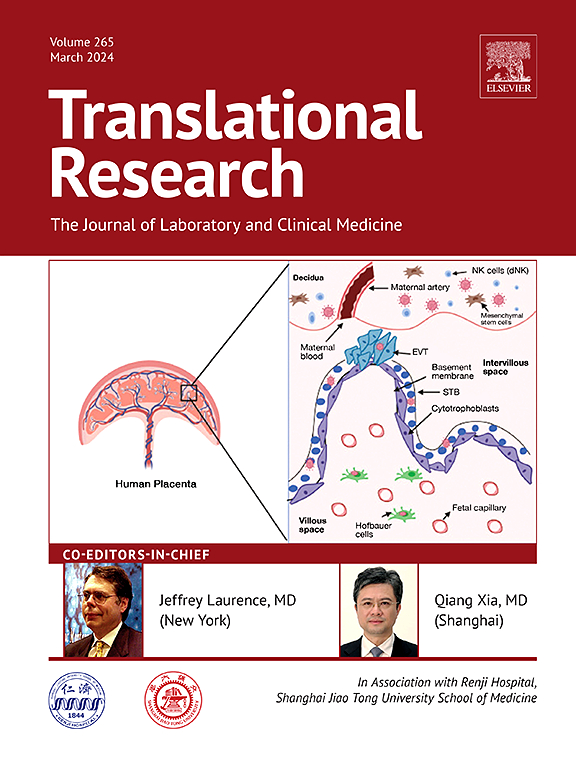Cardioprotective effects of PARP Inhibitors: A meta-analysis of animal studies
IF 5.9
2区 医学
Q1 MEDICAL LABORATORY TECHNOLOGY
引用次数: 0
Abstract
Poly(adenosine diphosphate [ADP] ribose) polymerase (PARP) inhibitors are expected to provide benefits to the cardiovascular system. However, the cardioprotective effect of PARP inhibitors has not been systematically reviewed or quantitatively analyzed. This study aimed to assess the cardioprotective effects of PARP inhibitors through a meta-analysis of animal studies. Three databases PubMed, Web of Sciences, and Embase were searched until September 1, 2023. The risk of bias was assessed using SYRCLE’s Risk of Bias. A total of 74 animal studies that investigated the cardiac function of PARP inhibitors compared to placebo or vehicle, were included. Outcome measures were hemodynamic indexes, cardiac contractility, and biomarkers of myocardial injury. Pooled effect size was estimated using a random-effects model with RevMan 5.4. PARP inhibitors were associated with enhanced hemodynamic indexes, including cardiac output (standardized mean difference, 0.86 [95 % CI, 0.54 to 1.17]; p < 0.00001) and stroke volume (0.42 [0.07 to 0.76]; p = 0.02). PARP inhibitors were associated with increased cardiac contractility, including ejection fraction (0.71 [0.42 to 1.01]; p < 0.00001) and fractional shortening (0.96 [0.62 to 1.31]; p < 0.00001). PARP inhibitors were associated with decreased troponin І (-1.42 [-2.16 to -0.68]; p = 0.0002), plasma B-type natriuretic peptide (-0.95 [-1.56 to -0.33]; p = 0.003), creatine kinase (-1.81 [-2.63 to -0.99]; p < 0.0001), and infarct size (-1.58 [-2.01 to -1.14]; p < 0.00001). PARP inhibitors improve cardiac functions and attenuate myocardial injury in animals, which indicate the cardioprotective effects. Further human studies are necessary.
PARP抑制剂的心脏保护作用:动物研究的荟萃分析
聚二磷酸腺苷[ADP]核糖)聚合酶(PARP)抑制剂有望为心血管系统提供益处。然而,PARP抑制剂的心脏保护作用尚未系统回顾或定量分析。本研究旨在通过动物研究的荟萃分析来评估PARP抑制剂的心脏保护作用。检索了PubMed、Web of Sciences和Embase三个数据库,直到2023年9月1日。偏倚风险采用sycle的偏倚风险评估。共纳入74项动物研究,研究了PARP抑制剂与安慰剂或对照剂的心功能。结果测量血液动力学指标、心脏收缩力和心肌损伤的生物标志物。使用RevMan 5.4的随机效应模型估计合并效应大小。PARP抑制剂与血流动力学指标增强相关,包括心输出量(标准化平均差,0.86 [95% CI, 0.54至1.17];p & lt;0.00001)和行程体积(0.42 [0.07 ~ 0.76];P = 0.02)。PARP抑制剂与心脏收缩力增加相关,包括射血分数(0.71 [0.42 ~ 1.01];p & lt;0.00001)和分数缩短(0.96[0.62至1.31];p & lt;0.00001)。PARP抑制剂与肌钙蛋白降低І相关(-1.42[-2.16至-0.68];p = 0.0002),血浆b型利钠肽(-0.95 [-1.56 ~ -0.33];P = 0.003),肌酸激酶(-1.81 [-2.63 ~ -0.99];p & lt;0.0001),梗死面积(-1.58[-2.01至-1.14];p & lt;0.00001)。PARP抑制剂可改善动物心功能,减轻心肌损伤,表明其具有心脏保护作用。进一步的人体研究是必要的。
本文章由计算机程序翻译,如有差异,请以英文原文为准。
求助全文
约1分钟内获得全文
求助全文
来源期刊

Translational Research
医学-医学:内科
CiteScore
15.70
自引率
0.00%
发文量
195
审稿时长
14 days
期刊介绍:
Translational Research (formerly The Journal of Laboratory and Clinical Medicine) delivers original investigations in the broad fields of laboratory, clinical, and public health research. Published monthly since 1915, it keeps readers up-to-date on significant biomedical research from all subspecialties of medicine.
 求助内容:
求助内容: 应助结果提醒方式:
应助结果提醒方式:


